动词的-ing形式作状语
- 格式:doc
- 大小:31.00 KB
- 文档页数:3
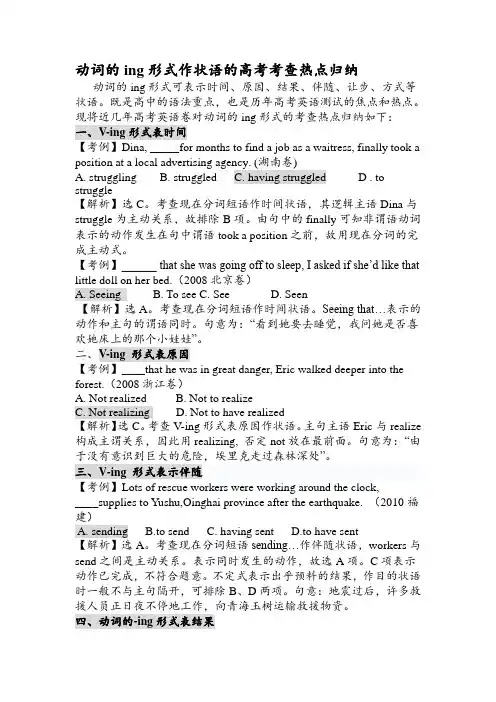
动词的ing形式作状语的高考考查热点归纳动词的ing形式可表示时间、原因、结果、伴随、让步、方式等状语。
既是高中的语法重点,也是历年高考英语测试的焦点和热点。
现将近几年高考英语卷对动词的ing形式的考查热点归纳如下:一、V-ing形式表时间【考例】Dina, _____for months to find a job as a waitress, finally took aposition at a local advertising agency. (湖南卷)A. strugglingB. struggledC. having struggled D . to struggle【解析】选C。
考查现在分词短语作时间状语,其逻辑主语Dina与struggle为主动关系,故排除B项。
由句中的finally可知非谓语动词表示的动作发生在句中谓语took a position之前,故用现在分词的完成主动式。
【考例】______ that she was going off to sleep, I asked if she’d like thatlittle doll on her bed.(2008北京卷)A. SeeingB. To seeC. SeeD. Seen【解析】选A。
考查现在分词短语作时间状语。
Seeing that…表示的动作和主句的谓语同时。
句意为:“看到她要去睡觉,我问她是否喜欢她床上的那个小娃娃”。
二、V-ing 形式表原因【考例】____that he was in great danger, Eric walked deeper into theforest.(2008浙江卷)A. Not realizedB. Not to realizeC. Not realizingD. Not to have realized【解析】选C。
考查V-ing形式表原因作状语。
主句主语Eric与realize 构成主谓关系,因此用realizing, 否定not放在最前面。
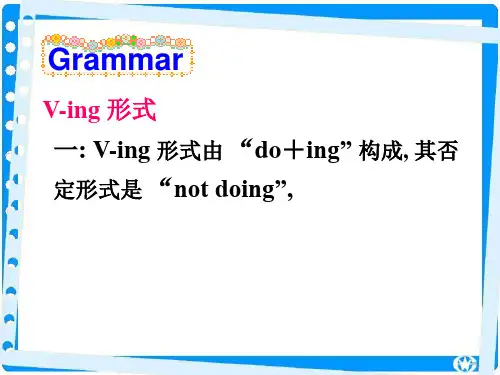
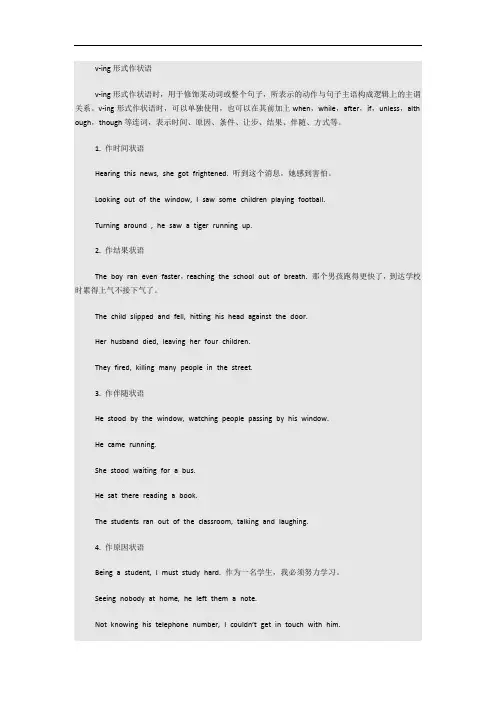
v-ing形式作状语v-ing形式作状语时,用于修饰某动词或整个句子,所表示的动作与句子主语构成逻辑上的主谓关系。
v-ing形式作状语时,可以单独使用,也可以在其前加上when,while,after,if,unless,alth ough,though等连词,表示时间、原因、条件、让步、结果、伴随、方式等。
1. 作时间状语Hearing this news, she got frightened. 听到这个消息,她感到害怕。
Looking out of the window, I saw some children playing football.Turning around , he saw a tiger running up.2. 作结果状语The boy ran even faster,reaching the school out of breath. 那个男孩跑得更快了,到达学校时累得上气不接下气了。
The child slipped and fell, hitting his head against the door.Her husband died, leaving her four children.They fired, killing many people in the street.3. 作伴随状语He stood by the window, watching people passing by his window.He came running.She stood waiting for a bus.He sat there reading a book.The students ran out of the classroom, talking and laughing.4. 作原因状语Being a student, I must study hard. 作为一名学生,我必须努力学习。
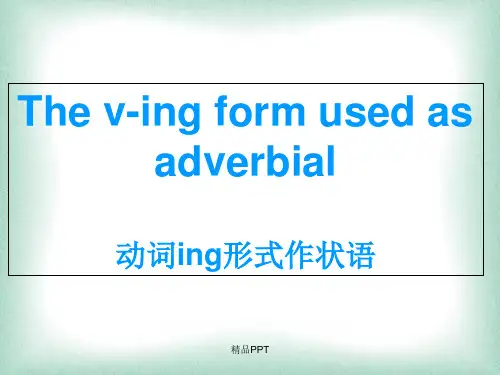
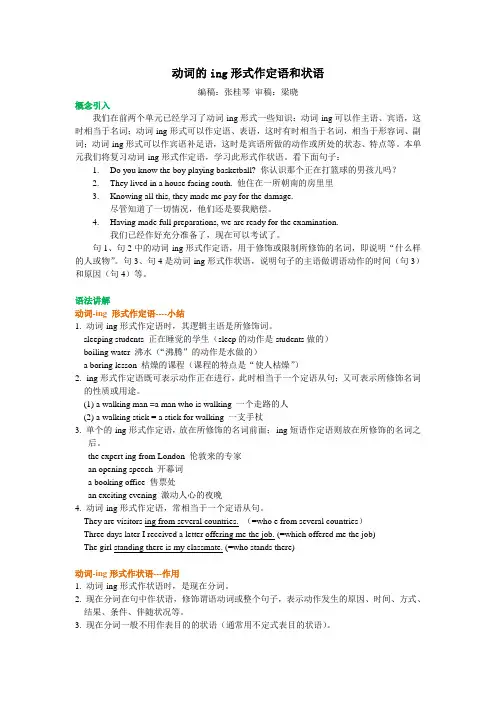
动词的ing形式作定语和状语编稿:张桂琴审稿:梁晓概念引入我们在前两个单元已经学习了动词-ing形式一些知识:动词-ing可以作主语、宾语,这时相当于名词;动词-ing形式可以作定语、表语,这时有时相当于名词,相当于形容词、副词;动词-ing形式可以作宾语补足语,这时是宾语所做的动作或所处的状态、特点等。
本单元我们将复习动词-ing形式作定语,学习此形式作状语。
看下面句子:1.Do you know the boy playing basketball? 你认识那个正在打篮球的男孩儿吗?2.They lived in a house facing south. 他住在一所朝南的房里里3.Knowing all this, they made me pay for the damage.尽管知道了一切情况,他们还是要我赔偿。
4. Having made full preparations, we are ready for the examination.我们已经作好充分准备了,现在可以考试了。
句1、句2中的动词-ing形式作定语,用于修饰或限制所修饰的名词,即说明“什么样的人或物”。
句3、句4是动词-ing形式作状语,说明句子的主语做谓语动作的时间(句3)和原因(句4)等。
语法讲解动词-ing 形式作定语----小结1. 动词-ing形式作定语时,其逻辑主语是所修饰词。
sleeping students 正在睡觉的学生(sleep的动作是students做的)boiling water 沸水(“沸腾”的动作是水做的)a boring lesson 枯燥的课程(课程的特点是“使人枯燥”)2. -ing形式作定语既可表示动作正在进行,此时相当于一个定语从句;又可表示所修饰名词的性质或用途。
(1) a walking man =a man who is walking 一个走路的人(2) a walking stick = a stick for walking 一支手杖3. 单个的-ing形式作定语,放在所修饰的名词前面;-ing短语作定语则放在所修饰的名词之后。

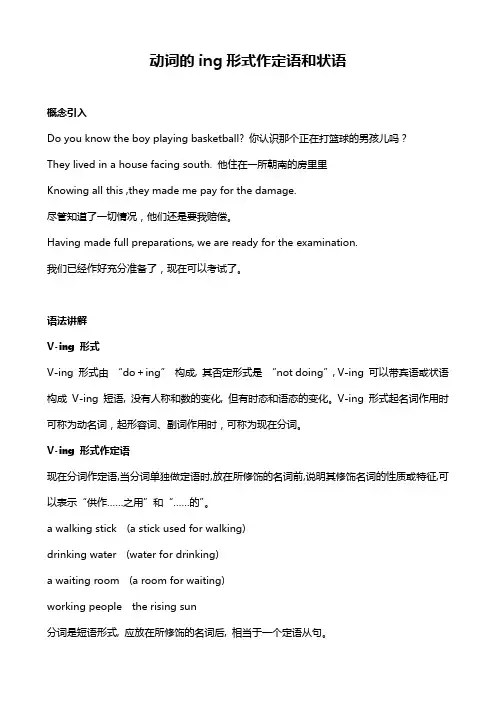
动词的ing形式作定语和状语概念引入Do you know the boy playing basketball? 你认识那个正在打篮球的男孩儿吗?They lived in a house facing south. 他住在一所朝南的房里里Knowing all this ,they made me pay for the damage.尽管知道了一切情况,他们还是要我赔偿。
Having made full preparations, we are ready for the examination.我们已经作好充分准备了,现在可以考试了。
语法讲解V-ing 形式V-ing 形式由“do+ing”构成, 其否定形式是“not doing”, V-ing 可以带宾语或状语构成V-ing 短语, 没有人称和数的变化, 但有时态和语态的变化。
V-ing 形式起名词作用时可称为动名词,起形容词、副词作用时,可称为现在分词。
V-ing 形式作定语现在分词作定语,当分词单独做定语时,放在所修饰的名词前,说明其修饰名词的性质或特征,可以表示“供作……之用”和“……的”。
a walking stick (a stick used for walking)drinking water (water for drinking)a waiting room (a room for waiting)working people the rising sun分词是短语形式, 应放在所修饰的名词后, 相当于一个定语从句。
They are visitors coming from several countries.who come from several countries.Three days later I received a letter offering me the job.which offered me the job.The girl standing there is my classmate.who stands there现在分词作状语现在分词作状语时, 分词的逻辑主语必须是句子的主语, 分词必须和句中的主语含有逻辑上的主谓关系, 否则不能用现在分词作状语。

动词的-ing形式作状语【观察】观察下列句子中动词的-ing形式作状语的用法,然后加以总结。
1. Arriving at the classroom, the children began to do cleaning.2. She doesn’t feel like eating anything, being ill for a few days.3. Working hard, you will succeed sooner or later.4. Weighing almost one hundred kilos, the stone was moved by him alone.5. The song is sung all over the country, making it very popular.6. Travelling by car, we visited many exciting and beautiful places.7. While/When reading the book, he nodded from time to time.8. Make sure to read all choices before deciding on the best answer.9. After finishing reading the letter, he went on to write a reply.10. On/Upon hearing their teacher’s voice, the pupils stopped talking at once.11. The car was caught in a traffic jam, thus causing the delay.12. Though/Although raining heavily, it cleared up very soon.13. I have accepted this, not wanting to disappoint them.14. Generally speaking, people like to hear compliments from others.【总结】Ⅰ. 动词的-ing形式作状语的用法动词的-ing形式作状语,通常表示主语正在进行的另一动作,用来对谓语动词表示的动作加以修饰或作为陪衬。
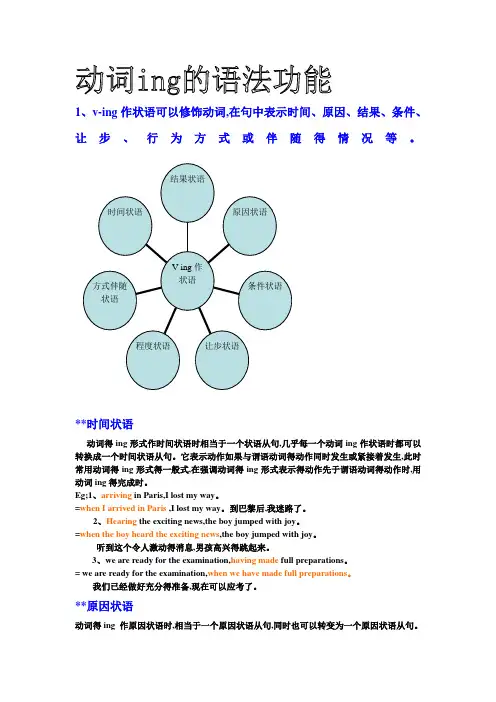
1、v-ing作状语可以修饰动词,在句中表示时间、原因、结果、条件、让步、行为方式或伴随得情况等。
**时间状语动词得ing形式作时间状语时相当于一个状语从句,几乎每一个动词ing作状语时都可以转换成一个时间状语从句。
它表示动作如果与谓语动词得动作同时发生或紧接着发生,此时常用动词得ing形式得一般式,在强调动词得ing形式表示得动作先于谓语动词得动作时,用动词ing得完成时。
Eg;1、arriving in Paris,I lost my way。
=when I arrived in Paris ,I lost my way。
到巴黎后,我迷路了。
2、Hearing the exciting news,the boy jumped with joy。
=when the boy heard the exciting news,the boy jumped with joy。
听到这个令人激动得消息,男孩高兴得跳起来。
3、we are ready for the examination,having made full preparations。
= we are ready for the examination,when we have made full preparations。
我们已经做好充分得准备,现在可以应考了。
**原因状语动词得ing 作原因状语时,相当于一个原因状语从句,同时也可以转变为一个原因状语从句。
它表示得原因得动词ing 形式短语一般置于句首。
Eg;1、having smoked too much ,he has suffered from lung cancer。
=as he has smoked too much ,he has suffered from lung cancer由于抽烟过多,她得了肺癌。
2、living far from my pany,I have to get up early。
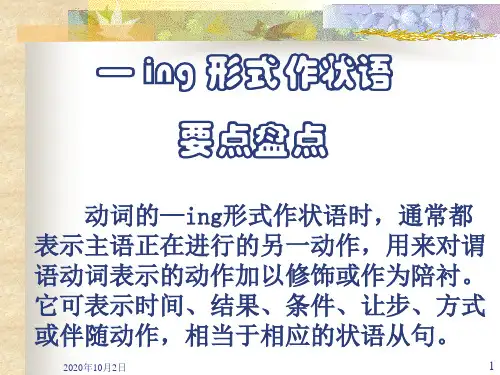

状语从句ing形式-ing形式的状语从句是指以动词-ing形式作为从句谓语的句子. 它可以用来修饰主句的谓语动词, 表示两件同时发生的事情或先后发生的事情.例如:- Feeling tired, she went to bed early. (感到疲惫, 她早早就上了床.)- Knowing the answer, he raised his hand. (知道答案, 他举起了手.)这里的-ing形式状语从句分别修饰了主句的谓语动词"went to bed"和"raised his hand".-ing形式的状语从句可以表示时间, 原因, 目的, 条件等.下面是一些常见的-ing形式状语从句及其相关参考内容:时间状语从句:- Walking down the street, she heard a noise. (走在街上时, 她听到了噪音.)- Watching the sunset, we felt happy. (看着日落, 我们感到很开心.)原因状语从句:- Knowing him well, I trusted him. (认识他很久, 我相信他)- Being tired, he couldn't concentrate. (因为疲累, 他无法集中注意力.)条件状语从句:- If you keep working hard, you will achieve your goal. (如果你一直保持努力, 你会实现你的目标.)- Without studying, you won't pass the exam. (如果不学习, 你不会通过考试.)目的状语从句:- He went to the store to buy some milk, forgetting he had already bought some. (他为了买牛奶去了商店, 忘记自己已经买了一些.) - She took the umbrella with her, hoping it wouldn't rain. (她带着伞走了, 希望不会下雨.)-ing形式的状语从句在英语中使用频率较高, 学好相关用法对于提升英语语言能力有很大帮助.。
非谓语动词用法解析动词ing作目的状语非谓语动词用法解析:动词-ing作目的状语动词-ing作目的状语是非谓语动词的一种常见用法。
在句子中,动词-ing形式可以作为目的状语,表示主语的动作或状态的目的或用途。
本文将对非谓语动词-ing作目的状语的用法进行详细解析。
一、形式动词-ing作目的状语的形式为动词的现在分词形式,即动词原形 + ing。
例如:1. I went shopping to buy some groceries.我去购物是为了买些杂货。
2. She stayed up late to finish her project.她熬夜是为了完成她的项目。
3. They studied hard to pass the exam.他们努力学习是为了通过考试。
二、用法1. 表示主语的目的或用途动词-ing作目的状语可以说明主语进行某个动作或处于某种状态的目的或用途。
例如:1. They traveled to experience different cultures.他们旅行是为了经历不同的文化。
2. The students worked hard to earn good grades.学生们努力学习是为了获得好成绩。
3. He went to the gym to build muscle.他去健身房是为了增肌肉。
2. 与动词不定式互换有些句子可以使用动词-ing作目的状语或动词不定式作目的状语,表示相同的意思。
这时候,动词-ing往往更常用于口语或非正式场合。
例如:1. He went to the store to buy milk. 或 He went to the store buying milk.他去商店是为了买牛奶。
2. She came to the party to meet new people. 或 She came to the party meeting new people.她来参加派对是为了结识新的人。
动词的-ing形式作状语
【观察】 观察下列句子中动词的-ing形式作状语的用法,然后加以总结。
1. Arriving at the classroom, the children began to do cleaning.
2. She doesn’t feel like eating anything, being ill for a few days.
3. Working hard, you will succeed sooner or later.
4. Weighing almost one hundred kilos, the stone was moved by him alone.
5. The song is sung all over the country, making it very popular.
6. Travelling by car, we visited many exciting and beautiful places.
7. While/When reading the book, he nodded from time to time.
8. Make sure to read all choices before deciding on the best answer.
9. After finishing reading the letter, he went on to write a reply.
10. On/Upon hearing their teacher’s voice, the pupils stopped talking at once.
11. The car was caught in a traffic jam, thus causing the delay.
12. Though/Although raining heavily, it cleared up very soon.
13. I have accepted this, not wanting to disappoint them.
14. Generally speaking, people like to hear compliments from others.
【总结】
Ⅰ. 动词的-ing形式作状语的用法
动词的-ing形式作状语,通常表示主语正在进行的另一动作,用来对谓语动词表示的动作加
以修饰或作为陪衬。它可表示时间、条件、原因、让步、结果、方式或伴随动作,相当于相
应的状语从句。
◆作时间状语,多置于句首,也可置于句末。(如例句1)
◆作原因状语,多置于句首或句末,也可置于句中。(如例句2)
◆作条件状语,多置于句首。(如例句3)
◆作让步状语,多置于句首。(如例句4)
◆作结果状语,多置于句末。(如例句5)
◆作方式或伴随状语,多置于句末,也可置于句首。(如例句6)
【区别】 动词的-ing形式和动词不定式作结果状语:
动词的-ing形式表示“正常出现的、自然而然的或意料之中的”结果。通常位于句末,其前有
逗号隔开。有时为了强调,可在现在分词前加副词thus, therefore等。
动词不定式表示意料之外的结果。尤其是和only连用。如:
She ran to the station, only to find that the train had left.
【特别提醒】 为强调-ing形式所表达的意义,在-ing形式短语前可用连词、介词或副词。
◆“when/while+-ing形式”强调-ing形式与谓语动词的动作同时发生。(如例句7)
◆“before + -ing形式”强调-ing形式在谓语动词所表示的动作之后发生。(如例句8)
◆“after+动词的-ing形式”强调-ing形式在谓语动词所表示的动作之前发生。(如例句9)
◆“on/upon + -ing形式”表示“一(刚)……就……”。(如例句10)
◆“thus + -ing形式”表示结果。(如例句11)
◆“though /although+ -ing形式”表示让步。(如例句12)
Ⅱ. 动词的-ing形式的否定形式
动词的-ing形式的否定形式为“not+-ing形式”。(如例句13)
【难点点拨】 动词的-ing形式作状语应该注意的问题:
◆现在分词作状语时,其逻辑主语必须与句子的主语一致,且为主动关系。
◆独立成分作状语。常见的有:generally speaking一般地说;strictly speaking 严格地说;frankly
speaking 坦率地说;exactly speaking 确切地说;judging from/by 由……判断出。(如例句14)
语法巩固练习
句型转换。(每空一词)
1. I stood by the door, and did not dare to say a word.
→I stood by the door, to say a word.
2. I could not but laugh as soon as I saw such a funny sight.
→I could not but laugh such a funny sight.
3. While he was working in the factory, he was an advanced worker.
→ in the factory, he was an advanced worker.
→ in the factory, he was an advanced worker.
4. Because I didn’t know his telephone number, I couldn’t ring him.
→ his telephone number, I couldn’t ring him.
5. Look on the bright side of things, and you will live happily.
→ on the bright side of things, you will live happily.
→ on the bright side of things, you will live happily.
6. Before you leave the classroom, please turn off the lights.
→ the classroom, please turn off the lights.
7. He worked day and night, and as a result it made himself near-sighted.
→He worked day and night, himself near-sighted.
→He worked day and night, himself near-sighted.
8. The three young girls stood under the tree, and they laughed and talked merrily.
→The three young girls stood under the tree, and merrily.
Keys:
1. not daring 2. on/upon seeing
3. Working; While working 4. Not knowing
5. If you look; Looking 6. Before leaving
7. making; thus making 8. laughing; talking